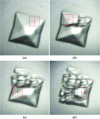In situ macromolecular crystallography using microbeams
- PMID: 22525757
- PMCID: PMC4791750
- DOI: 10.1107/S0907444912006749
In situ macromolecular crystallography using microbeams
Abstract
Despite significant progress in high-throughput methods in macromolecular crystallography, the production of diffraction-quality crystals remains a major bottleneck. By recording diffraction in situ from crystals in their crystallization plates at room temperature, a number of problems associated with crystal handling and cryoprotection can be side-stepped. Using a dedicated goniometer installed on the microfocus macromolecular crystallography beamline I24 at Diamond Light Source, crystals have been studied in situ with an intense and flexible microfocus beam, allowing weakly diffracting samples to be assessed without a manual crystal-handling step but with good signal to noise, despite the background scatter from the plate. A number of case studies are reported: the structure solution of bovine enterovirus 2, crystallization screening of membrane proteins and complexes, and structure solution from crystallization hits produced via a high-throughput pipeline. These demonstrate the potential for in situ data collection and structure solution with microbeams.
© 2012 International Union of Crystallography
Figures







References
-
- Adams, P. D. et al. (2010). Acta Cryst. D66, 213–221.
-
- Bingel-Erlenmeyer, R., Olieric, V., Grimshaw, J. P. A., Gabadinho, J., Wang, X., Ebner, S. G., Isenegger, A., Schneider, R., Schneider, J., Glettig, W., Pradervand, C., Panepucci, E. H., Tomizaki, T., Wang, M. & Schulze-Briese, C. (2011). Cryst. Growth Des. 11, 916–923.
-
- Brünger, A. T., Adams, P. D., Clore, G. M., DeLano, W. L., Gros, P., Grosse-Kunstleve, R. W., Jiang, J.-S., Kuszewski, J., Nilges, M., Pannu, N. S., Read, R. J., Rice, L. M., Simonson, T. & Warren, G. L. (1998). Acta Cryst. D54, 905–921. - PubMed
-
- Cockburn, J. J. B., Bamford, J. K. H., Grimes, J. M., Bamford, D. H. & Stuart, D. I. (2003). Acta Cryst. D59, 538–540. - PubMed
Publication types
MeSH terms
Substances
Grants and funding
LinkOut - more resources
Full Text Sources
Other Literature Sources

